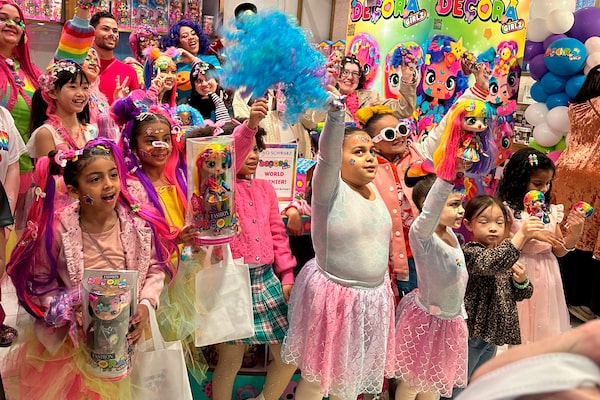
Some of the 30 child influencers invited by toy company Cepia LLC wave at an event held to launch its new fashion doll line called Decora Girlz, at an FAO Schwarz store on March 2 in New York. Cepia began investing in TikTok in 2019.Anne D'Innocenzio/The Associated Press
Vass Bednar is the founder of Regs to Riches, a senior fellow at the Centre for International Governance Innovation, and the executive director of McMaster University’s master of public policy in digital society program.
Canada’s recently introduced Online Harms Act endeavours to establish a baseline standard to keep young people safe online. Some schools are introducing cellphone bans to protect children from a major source of distraction, and four Ontario school boards are suing the owners of Instagram, Snapchat and TikTok over the alleged harms their platforms have caused students.
These moves are a response to long-standing trends. Social psychologist Jonathan Haidt’s controversial new book, The Anxious Generation, chronicles the decline of a play-based childhood that has been supplanted by a phone-based childhood. He points to a parental paradox that overemphasized protecting young people from real-world risks while abandoning this vigilance online.
It’s notable that some Gen Z children have started to cover their faces in family photos to exert some autonomy. Lately, they’ve been speaking out – often anonymously – about the stress that some have experienced through their parents video-blogging their lives growing up.
Which brings us to an important issue that isn’t talked about enough: Despite some recent efforts, our laws have generally looked the other way when it comes to the personal and financial interests of children on social media. We haven’t equated performative online work with more traditional work that happens offline. While provinces have labour laws that protect these young performers from exploitation, their structure sort of falls apart when the “employer” is the parent. The country shouldn’t overlook this policy gap.
Laidlaw and Owen: Canada’s Online Harms Act gets the big things right
There is plenty of recent inspiration to draw on. In 2020, France adopted a law to protect child influencers on social media. Last summer, Illinois was the first U.S. state to ensure that child social-media influencers are compensated for their work. Recently, the California state Senate unanimously passed the Child Content Creator Rights Act. The legislation stipulates that content creators featuring minors in at least 30 per cent of their content are required to set aside a proportionate percentage of their earnings in a trust for the minor’s access upon reaching adulthood. Additionally, the child must be paid for profits generated by their likeness. The intention is to prevent the exploitation of children who are monetized as child content creators, family vloggers, and the children of social-media influencers. Similarly, Ohio’s Kidfluencer Protection Act requires vlogger parents to set aside money for their children who appear in their videos, while Washington State’s HB 167 legislation grants the children of online influencers the right to request permanent deletion of their likenesses, names or photos.
These modifications presume that the core policy problem is fair compensation for children. This approach skirts a bigger conversation about how comfortable we are with people monetizing the experiences and appearance of their kids in exchange for ad revenue and other forms of compensation.
Ontario has introduced some guardrails for child performers. The Protecting Child Performers Act (2015) sets out the minimum requirements for employing or contracting the services of child performers, whether the child is in the live entertainment industry (theatre, dance, music, opera, circus) or the recorded entertainment industry (in cinemas, on the internet, in radio or television broadcasts, or DVDs). But it is vague on the allocation of earnings from social-media “influencing,” and there’s a grey zone when a parent is also the employer. Plus, when a child is performing as themselves online, are we comfortable calling that entertainment when it could be something closer to labour?
YouTube and Instagram ban children under 13 from even having their own accounts in the first place. Yet Prof. Veena Dubal of the University of California, whose work looks at the intersection of law and technology, has argued that Google’s YouTube could be conceived of as a “joint employer” of child influencers because it controls the dissemination of money.
We have plenty to catch up on when it comes to modernizing our legislative infrastructure to ensure that it adequately reflects reality. While we work to tackle the biggest digital policy problems plaguing society, we can’t forget that modest updates can be powerful, too.
Kids need to be free to have fun. That joy and exploration should be protected and cherished, and probably shouldn’t be monetized in the advertising ecosystem. But if it is, these young performers should at the very least be entitled to a significant share of the subsequent funds.
We’ve made massive policy progress erasing and rejecting the norm of child labour, and yet we scroll through it on our phones regularly. Other jurisdictions are evolving their frameworks to better support the young people who perform in our feeds. That kind of policy diffusion is worth oversharing, fast.